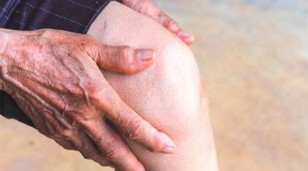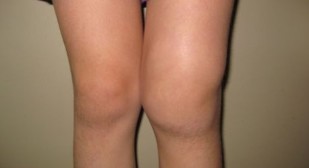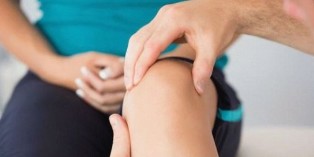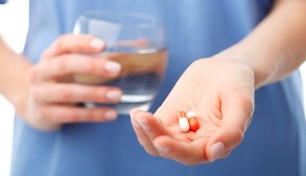Osteoarthritis of the knee joint (gonarthrosis) is a disease characterized by degenerated-degenerative changes in cartilage, menisci, and bones of the formants of the knee joint. The disease occupies a special place among the musculoskeletal pathologies.

The reasons of the knee
Osteoarthritis of the knee is polyetiological disease, either by the state, when the development of pathological changes contribute to several of the causal factors. In this case it is said on the primary (a) of the oa. In a second the gonarthrosee it specifies the factor that caused the disease.
The main causes of osteoarthritis are:
- a knee injury;
- the surgical interventions in the area of the knee;
- the increase of the physical activity;
- overweight, obesity;
- congenital lower limb;
- the syndrome of connective tissue dysplasia;
- the violation of the metabolism;
- general disease (diabetes, rheumatoid arthritis, acromegaly).
It is important!
The traumatic impact of the agent is the main cause of osteoarthritis at a young age. Injuries to the knee, leading to osteoarthritis, sprains, in particular, diseases or damage of the menisci.
The development of pathological changes is the need of mobilization of the joint after an injury, it contributes to the deterioration of the blood circulation in the tissues, periarticular, at the same time that the reports of mechanical damage leads to long-term, the healing and the development of signs of osteoarthritis.
The Increased activity manifests itself not only in an intense exercise, but in the presence of an excess of weight. Excess weight and exercise, is not appropriate to the age and level of physical ability of man, lead to the appearance of micro-cracks in the cartilage or the menisci, which is the first link in the process of the formation of the knee.
Congenital lower limb, that is shortening of one of the members of the dysplasia, as well as valgus or varus deformity of the toes leads to the onset of osteoarthritis due to the uneven distribution of the weight of a person. After this clears the cartilage, formed a focus of inflammation aseptic with the characteristic appearance of the clinical symptoms of osteoarthritis.
The syndrome of connective tissue dysplasia is characterized by a hyper-mobility and the insufficiency of the ligamentous apparatus. Resulting from the joint increases the amplitude of the movements, until the pathological. Such instability is quickly led to the emergence of repetitive strain injuries of the menisci and articular surfaces of cartilage.
Infringement of a metabolism and the presence of pathology somatic causes the development of osteoarthritis due to a violation of the microcirculation in the knee joint, deterioration of the nutrition of the cartilage and menisci, the deterioration of the composition of liquid intra-articular.
Classification
The code of the ICD-10 – maintenance m17. Depending on the etiological factor for the development of osteoarthritis, secrete one of the following categories:
- Maintenance m17.0 – primary gonarthrosis duplex;
- Maintenance m17.1 – a other primary gonarthrosis;
- Maintenance m17.2 post – traumatic gonarthrosis, bilateral;
- Maintenance m17.3 – other post-traumatic gonarthrosis;
- Maintenance m17.4 – other secondary gonarthrosis, bilateral;
- Maintenance m17.5 – other secondary gonarthrosis;
- Maintenance m17.9 – the knee is not updated.

There are types of osteoarthritis of the knee:
- involution – occurs due to changes in age of the body, metabolic disturbances, wear of the articular surfaces of the bones;
- in dysplastic – associated with congenital abnormalities of the lower limbs;
- post-traumatic stress disorder;
- metabolic – occurs when the diseases accompanied by metabolic disorders (gout, chondrocalcinosis);
- dishormonal manifesto with a hormonal imbalance in the body diabetes, menopause, disorders of the function of the thyroid gland;
- the after-inflammatory – occurs after infectious, inflammatory diseases of the knee joint;
- static – occurs as a result of the excessive physical loads, poor weight distribution, obesity;
- ischemic – associated with disorders of the blood supply to the knee area.
Pathogenesis
The disease develops gradually. First, the changes appear in the Podhradie layer – formed cracks. The appearance of micro-cracks caused the continued action of the knee joint, one of its functions is to absorb the shocks when walking. And if the etiological factors of the load on the knee increases even more, and the process of destruction begin to exceed the rebuilding process of cartilage, leading to cracks.
Subsequently, in the cracks penetrates the synovial fluid and form cysts, which have a tendency to increase and the merger. The great the cysts begin to compress the blood vessels that feed the cartilage, leading to hypoxia in the cartilage. Violated the metabolism, the deterioration of the synthesis of collagen, necessary for cartilage repair. Given the poor recovery of the cartilage, gradual in its thinning, resulting in disturbances of the joint function, appear the clinical signs of the disease.
On the note!
With the progression begin to form osteophytes – bony expansion. Osteophytes, mainly located on the edges of the articular surfaces of the bones. Their presence causes expressed by an inflammatory reaction in the joint, pain, joint deformity, limitation of mobility.
With the development of the inflammatory process observed a swelling of the tissues, which leads to an increase of the pressure in the joint, the deterioration of the composition of fluid, intra-articular, alteration of nutrition of the cartilage.
The clinical symptoms of the
In the course of the disease distinguish several degrees of osteoarthritis, which reflect the process of progression of pathological changes that have clinical manifestations.
The symptoms of osteoarthritis of the knee joint can be divided into stages:
- The first stage of the disease is characterized by the appearance of pain in the area of the knee, especially after physical stress, intense or prolonged to find on the feet. Less favourable to the static load, it is to lift weights. Pain in the joint goes alone after the rest. In addition to the pain can be a crackling or clicking in the joint, which testifies to the violation of the congruence of the articular surfaces of the bones formant articulation, and the appearance of micro-cracks in the cartilage. The lack strongly expressed by the use of clinical signs as a result, most patients do not see a doctor in the initial phase, leading to delays in diagnosis.
- The progression of the disease leads to the formation of more express, the pain syndrome – the pain occurs even after a load, you don't pass. You get in the morning stiffness in the joint, lasting about 30 minutes, but if it joins the inflammation, the stiffness can last up to 1 hour. Because of the severe pain a person begins to save the leg, decreases the amplitude of the movements, appears to be limping. Because of the edema of the tissues of the knee increases in volume. Appear to be radiological evidence of osteoarthritis of the knee.
- The appearance of osteophytes characterized the development of the 3 stage of the disease is strongly expressed pain syndrome, even at rest, the bad jugulate drugs. The movements are practically non-existent, the knee joint is deformed. May be a blockage of the knee in a specific position, as well as dislocations or subluxations.

Diagnosis
The diagnosis of osteoarthritis is made up of several components:
- The complaints of the patient.
- The history of the development of the disease.
- The anamnesis of the life of the patient.
- Laboratory and instrumental methods of studies.
On the basis of the complaints of the patient, as well as the history of life and disease physician outlines the diagnosis. But to perform a differential diagnosis with other pathologies and to establish a precise diagnosis must be laboratory tests and instrumental methods.
The basic tool in the technical study of the knee joint are:
- x-ray;
- arthroscopy;
- ct scan;
- ultrasound;
- the magnetic resonance imaging.
It is important!
The primary means of diagnosis of oa is radiographic examination. The x-ray of the knee joint in two projections, which gives a complete picture on the changes. It is important to note that in the initial stages of osteoarthritis in the photo is not detected.
On the basis identified by radiological signs built x-ray classification of knee osteoarthritis:
- 1 degree – a little pinch of a joint;
- 2 degree – in a small joint space narrowing, the presence of the cord seal;
- 3 the degree – expressed to the narrowing of the joint space, presence of osteophytes, the first signs of bone deformity;
- 4 the degree d' expressed by the narrowing of the joint space up to its complete absence, of many of the osteophytes, the destruction of the osseous tissue, the deformity of the joint.
The other methods of investigation of the knee joint are a complement to the primary x-ray study. And are in addition to the diagnosis of the difficulty in the diagnosis.
Each of the diagnostic methods has its own indications, contraindications and different price, therefore, necessarily need to be appointed to a specialist if necessary.
How to treat osteoarthritis of the knee
The treatment of osteoarthritis of the knee joint, you need to start at the onset of the first clinical symptoms of the disease. The current treatment of osteoarthritis of the knee of the vise at all to restore the function of the joint and improving the quality of life of patients and is the following:
- the termination or reduction of the pain;
- the treatment of inflammation;
- recovery of the cartilage structure;
- the increase in the amplitude of movements;
- an improvement of the microcirculation of the tissue periarticular.

On the note! It is important to note that the different steps apply to different means of treatment. If the proper time to begin to fight against the disease, one can get rid not only of the pain, but to restore the knee joint with osteoarthritis, as well as prevent the occurrence of complications.
Applied to drug therapy helps reduce the pain and inflammatory reaction, it is obtained by the application of the non-steroidal anti-inflammatory drugs. For cartilage repair are appointed chondroprotector. The treatment plan is assigned and controlled by a doctor.
In addition to a medical treatment are appointed physiotherapy, ointment, gymnastics, massage or intra-injection of drugs.
That cure for osteoarthritis of the knee
In this case, the animals of the receipt of the gelatin, which can be taken inside or make a compress. The traditional medicine should not be administered as monotherapy, and be a part of all treatment activities. Before you start the treatment, like the house, you need to be familiar with the recommendations and comments.
Can you cure osteoarthritis
In the event of poor or late treatment of the consequences of the progression of the disease are not obliged to wait. The knee is dangerous, because even the best treatment cannot completely stop the process, but only slows down, but it allows a person more time to maintain the activity.
If the disease came with a severe stage, then the conservative treatment is ineffective. In step 3, move from a surgical treatment, after requiring long-term rehabilitation.





























